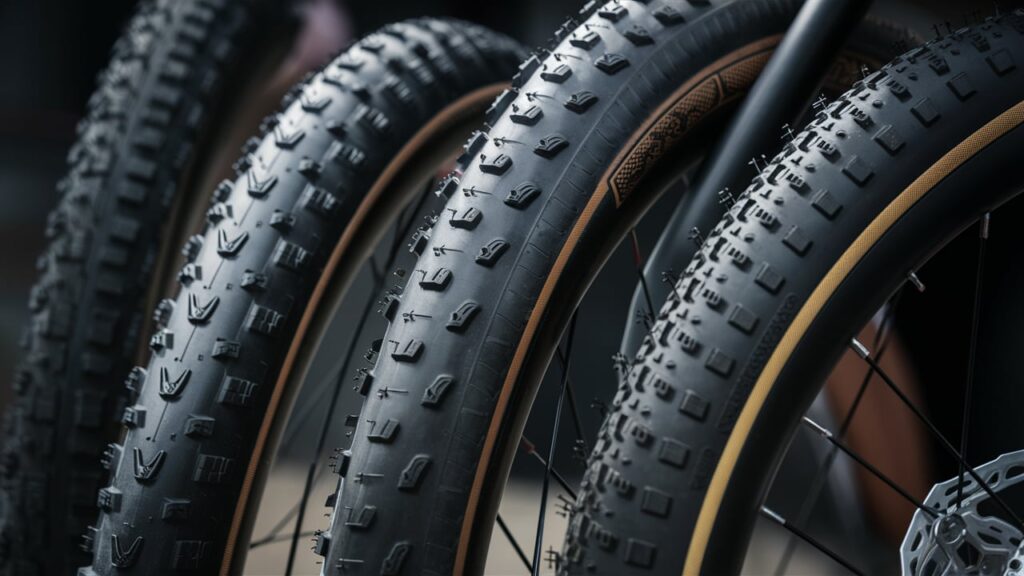Choosing the right tread pattern for a hybrid bike is crucial. It affects both speed on pavement and grip on light trails.
Hybrid bikes are popular for their versatility. They can handle city streets and light off-road paths. But the key to their performance lies in the tires. Different tread patterns offer various benefits. Some enhance speed on smooth roads, while others improve grip on rough trails.
Finding the right balance is essential. This blog will explore various tread patterns. You’ll learn how each type affects your ride. Whether you’re commuting or exploring, understanding tread patterns will help you get the best from your hybrid bike. Let’s dive into the details and find the perfect tread for your needs.
Introduction To Hybrid Bike Tread Patterns
Hybrid bikes are versatile, offering a blend of features from road and mountain bikes. The tread pattern on their tires plays a crucial role. It balances speed on pavement and grip on light trails. Understanding these tread patterns helps you choose the right bike for your needs.
Purpose And Importance
Tread patterns serve two main purposes. First, they provide traction. This helps in maintaining control on varied surfaces. Second, they affect the rolling resistance. Lower resistance means faster speeds on smooth roads. Higher resistance offers better grip on rough trails.
The importance of tread patterns cannot be overstated. They directly impact your riding experience. A good tread pattern ensures safety. It also enhances comfort. By choosing the right tread, you can enjoy both pavement and trails. This makes hybrid bikes a popular choice.
General Characteristics
Hybrid bike tires have unique features. Typically, they have a smooth center. This reduces rolling resistance on pavement. The edges have more pronounced treads. These provide grip on dirt paths and light trails.
Another characteristic is the tire width. Hybrid bike tires are usually wider than road bike tires. This offers better stability and comfort. The rubber compound also matters. Softer compounds offer more grip. Harder compounds last longer. The balance between these traits defines a good hybrid bike tire.
Types Of Tread Patterns
When choosing a hybrid bike, one of the most crucial aspects to consider is the tread pattern of the tires. The right tread can make a huge difference in your riding experience, offering a balanced performance on both pavement and light trails. Let’s dive into the various types of tread patterns available for hybrid bikes.
Slick Treads
Slick treads are characterized by their smooth surface, offering minimal rolling resistance. They are perfect for city commuting and road cycling. The lack of tread allows for faster speeds on paved surfaces. I once switched to slick treads for my daily commute, and the difference in speed and smoothness was immediately noticeable. However, they offer limited traction on wet or loose surfaces, so be cautious if your route involves such conditions.
Semi-slick Treads
Semi-slick treads strike a balance between slick and knobby tires. They feature a smooth center for efficient rolling on pavements with knobby edges for better grip on light trails. This makes them versatile for varied terrains. Imagine riding smoothly on the road and confidently transitioning to a park trail without changing your bike. If you often switch between urban and off-road environments, semi-slick treads could be your best bet.
Knobby Treads
Knobby treads are designed for superior grip on loose and uneven terrains. Their aggressive pattern provides excellent traction on dirt and gravel paths. While they may slow you down on pavements, the added control on trails is worth the trade-off. When I first tried knobby treads on a forest trail, the stability and grip were impressive. If your rides frequently involve off-road adventures, knobby treads will give you the confidence you need.
What type of terrain do you ride on the most? Choosing the right tread pattern can significantly enhance your biking experience, so think about where you ride and what you need from your tires. Make your hybrid bike work best for you by selecting the tread pattern that fits your lifestyle.
Pavement Speed Considerations
Tread patterns for hybrid bikes are crucial. They balance speed on pavement and grip on light trails. Riders need this dual function for a smooth and safe ride.
Cyclists with hybrid bikes need to balance speed and grip. Pavement speed depends on tread patterns. They can either help or hinder your ride. Choosing the right tread is crucial for smooth city rides.
Rolling Resistance
Rolling resistance affects how fast you can go. Lower resistance means less effort. Smooth treads reduce rolling resistance. They make your bike glide on pavement. Knobby treads increase resistance, slowing you down. For city rides, choose smoother treads.
Tread Design Impact
Tread design impacts your ride’s feel. Smooth treads offer better speed. They provide a stable ride on flat surfaces. Small knobs can also work. They give some grip without much resistance. Wide treads with big knobs are for trails. They slow you down on roads. Balance is key for hybrid bikes. Smooth center treads with side knobs can work well. They offer speed and some trail grip.
“`
Light Trail Grip Factors
When choosing a hybrid bike, tread patterns are crucial. They balance pavement speed with light trail grip. Light trail grip factors determine how well your bike handles off-road terrain.
Traction Needs
Traction is key for light trails. Hybrid bikes require tread patterns that provide grip on loose surfaces. Look for tires with small knobs. They offer better traction on dirt and gravel.
Tread Depth And Spacing
Tread depth impacts grip. Deeper treads dig into soft ground. This enhances stability and control. Tread spacing is equally important. Wider spacing prevents mud from clogging the tire. It keeps the bike moving smoothly on trails.
Balancing Speed And Grip
Balancing speed and grip is crucial for hybrid bike enthusiasts. Hybrid bikes need to perform well on both paved roads and light trails. The right tread pattern can make a significant difference. It ensures you ride smoothly on the pavement and maintain control on trails.
Compromise Solutions
Designers create compromise solutions to balance speed and grip. These treads feature a smooth center for efficient pavement riding. They also have knobby edges for better trail traction. This design allows riders to switch terrains without changing tires.
Dual-purpose Designs
Dual-purpose designs combine the best of both worlds. These treads offer a semi-slick center for reduced rolling resistance. They include side knobs for improved cornering on trails. With these designs, cyclists can enjoy speed and stability.
Material And Durability
Hybrid bike tread patterns are essential for balancing speed on pavement and grip on light trails. Quality materials ensure durability and performance. Proper tread design enhances safety and efficiency.
When choosing a hybrid bike, understanding the material and durability of the tread patterns is essential. You want a tire that can handle both smooth pavement and light trails without wearing out too quickly. Let’s dive into the specifics of rubber compounds and wear and tear to help you make an informed decision.
###
Rubber Compounds
The rubber compound used in your hybrid bike’s tires plays a crucial role in its performance and durability. Softer rubber compounds offer better grip, which is great for light trails. However, they tend to wear out faster on pavement.
On the other hand, harder rubber compounds last longer and are more suitable for pavement. But they might not provide the same level of grip on rougher terrains. You need to find a balance that suits your riding style.
Have you ever noticed how some tires feel sticky to the touch? That stickiness often indicates a softer compound. While this can be great for grip, be prepared for faster wear.
Wear And Tear
Wear and tear are inevitable, but understanding how your tires will degrade can help you extend their life. Regularly check for visible signs of wear like cracks, flat spots, and thinning tread.
Rotating your tires can also help distribute wear more evenly. Think of it like rotating the tires on your car. The front and back tires wear differently, so swapping them can extend their lifespan.
You should also consider the type of terrain you ride on most frequently. Pavement wears tires differently compared to trails. If you stick mainly to roads, you might prioritize durability over grip. For mixed terrain, look for hybrid tires designed to handle both environments well.
Do you remember the last time you had a tire blowout? Chances are, it was due to neglecting these wear indicators. Regular maintenance can save you from unexpected flats and costly replacements.
By understanding the materials and how they wear, you can make better choices for your hybrid bike tires. What kind of terrain do you ride on most? How often do you check your tires? These questions can guide you in choosing the perfect tread pattern for your needs.
Seasonal And Weather Adaptations
Hybrid bike tread patterns balance pavement speed and light trail grip. These treads ensure smooth rides on various surfaces. Adaptable for changing weather, they offer stability and traction.
Tread patterns for hybrid bikes are essential for balancing pavement speed and light trail grip. One critical aspect to consider is how these tread patterns adapt to seasonal and weather changes. Understanding how your bike performs under different conditions can significantly enhance your riding experience.
Wet Conditions
In wet weather, your hybrid bike’s tread pattern can make a big difference. Treads with deeper grooves and siping (thin slits) can channel water away. This helps maintain contact with the ground, reducing the risk of slipping.
Imagine riding through a sudden summer shower. Your tires need to cut through the water and grip the pavement to keep you safe. If you live in an area with frequent rain, look for hybrid bike tires designed specifically for wet conditions. They often feature softer rubber compounds that provide better grip on slick surfaces.
Do you feel the difference when you ride on wet roads? Paying attention to your bike’s tread can make those rainy rides less daunting.
Dry Conditions
On dry surfaces, the demands on your hybrid bike’s tires change. Smooth or semi-slick treads often work best. They reduce rolling resistance, making your ride faster and more efficient.
Think about a crisp fall day when the roads are dry and you want to cover some distance quickly. Tires with minimal tread offer less resistance and help you maintain speed with ease. However, a bit of tread is still beneficial for light trails or unexpected gravel patches.
Have you noticed how your bike handles differently on dry pavement versus trails? The right tread pattern strikes a balance, ensuring you can switch between terrains smoothly.
Your choice of tires can affect your overall riding experience. What has been your experience with different tread patterns in various weather conditions?
Choosing The Right Tread For Your Needs
Choosing the right tread for your hybrid bike can make a huge difference in your riding experience. Whether you’re speeding down paved roads or exploring light trails, the right tread pattern helps you maintain control and efficiency. Let’s break down how to choose the right tread based on your personal riding style and the environmental factors you encounter.
Personal Riding Style
Your personal riding style is a key factor in selecting the right tread. Do you enjoy long, smooth rides on pavement, or do you often find yourself on light trails? If you prefer the pavement, a slick or semi-slick tread pattern is ideal. It provides minimal resistance, allowing you to maintain speed and enjoy a smooth ride.
If you love the thrill of light trails, you need a tread with more grip. Knobby or semi-knobby treads offer better traction, especially on loose or uneven surfaces. They help you stay stable and in control, even when the terrain gets tricky. Think about your riding habits and choose a tread that matches your style.
Environmental Factors
Environmental factors also play a crucial role. Consider the weather and the type of terrain you usually ride on. In wet conditions, a tire with deeper grooves can help channel water away, reducing the risk of slipping. On dry roads, a smoother tread will suffice, ensuring you get the most speed and efficiency.
Also, think about the types of surfaces you encounter. If your route includes a mix of pavement and dirt paths, a hybrid tread pattern is your best bet. It provides a balance of speed and grip, keeping you prepared for different conditions. Pay attention to the environment and choose a tread that helps you ride safely and comfortably.
Choosing the right tread for your hybrid bike isn’t just about the bike—it’s about you. Reflect on your riding style and the environments you ride in. What tread pattern will enhance your experience and keep you safe? Share your thoughts and experiences below. Your insights might help another rider make the perfect choice!
Maintenance And Care Tips
Tread patterns for hybrid bikes offer a perfect mix of pavement speed and light trail grip. Regularly check tire pressure and ensure treads are clean to maintain performance.
Maintaining the tread patterns on your hybrid bike is essential for balancing pavement speed and light trail grip. Proper care extends the life of your tires and ensures a smooth, safe ride. Here are some maintenance and care tips to keep your hybrid bike tires in top shape.
Regular Inspections
Regularly inspect your tires for any wear and tear. Look for signs of uneven tread wear, which could indicate alignment issues.
Check for embedded debris like glass or small stones. This can prevent punctures and extend tire life.
Ensure the tire pressure is within the recommended range. Proper inflation improves performance and reduces the risk of flats.
Proper Cleaning
Clean your tires regularly with mild soap and water. This removes dirt and grime that can wear down the tread.
Use a soft brush to scrub the tires gently. Avoid using harsh chemicals that can degrade the rubber.
After cleaning, inspect the tires again. Sometimes cleaning can reveal hidden damage.
Taking these simple steps can make a big difference in the longevity and performance of your hybrid bike tires. How often do you check your tires? It might be time to start a regular routine.

Frequently Asked Questions
What Is The Best Tread Pattern For Grip?
The best tread pattern for grip features deep grooves and sipes. These provide excellent traction on wet and dry surfaces.
Which Tread Design Has The Strongest Traction Force?
Aggressive tread designs with deep, wide grooves offer the strongest traction force, ideal for off-road and snowy conditions.
What Is The Correct Tire Tread Orientation For A Bike?
The correct tire tread orientation for a bike is indicated by arrows on the sidewall. Ensure arrows point forward when mounted.
What Size Tires Are Best For Hybrid Bike?
The best tire size for a hybrid bike ranges from 28mm to 42mm. Choose based on your riding conditions and comfort needs.
Conclusion
Selecting the right tread patterns is crucial for hybrid bikes. It balances speed on pavement and grip on light trails. Riders can enjoy smooth rides and tackle diverse terrains. Proper tread patterns offer safety and performance. Consider your riding style and terrain.
Make informed choices for the best biking experience. Happy cycling!








